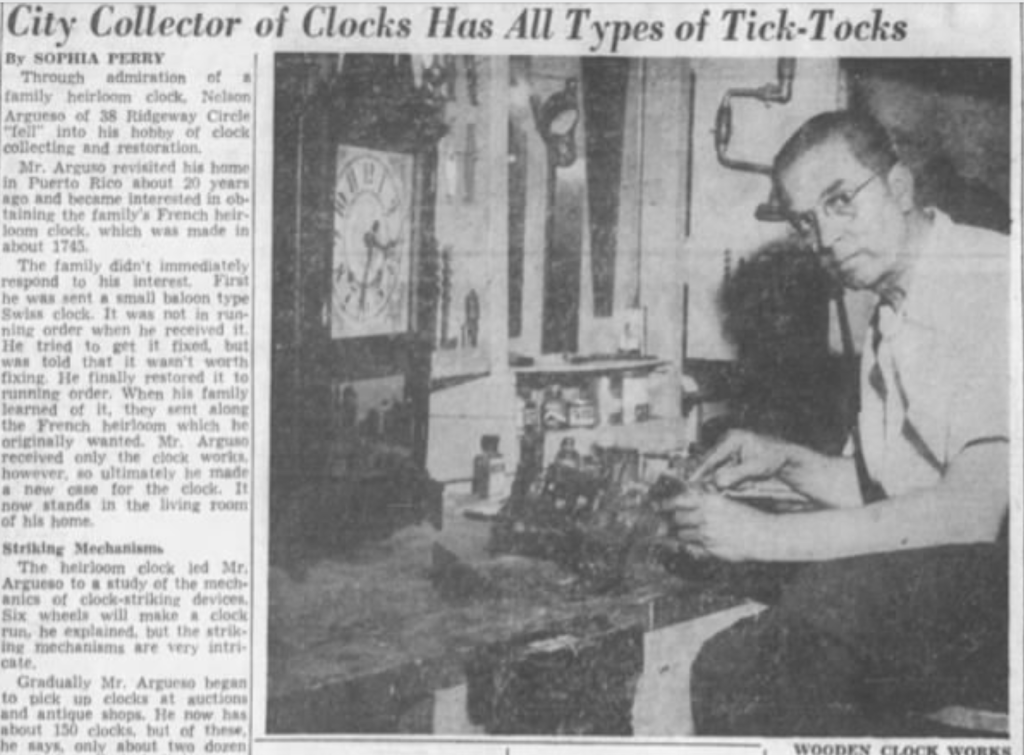
On July 28, 1954, The Reporter Dispatch ran a feature on Mr. Nelson Argueso of 38 Ridgeway Circle, White Plains, New York.
“City Collector of Clocks Has All Types of Tick-Tocks” focused almost entirely on this resident’s affinity for timekeeping machines. It shares his birthplace in Puerto Rico and his job as an accountant in passing. Three years later, when the same newspaper featured Marian Argueso, Nelson’s wife, and her recipe for shrimp with rice, that reporter only mentioned Nelson’s clock work and a job at an advertising firm.
These were charming human interest stories about a nice suburban couple. Nelson came across as the less interesting of the two. Marian’s interviewer noted her passion for cooking, music, sewing, rug hooking, and volunteering. Nelson liked clocks and tracked money. Whatever else made him tick was beyond the scope of the story.
That included Nelson Argueso’s work as a professional saxophonist with some of the most popular and admired names in music. Bandleaders Mal Hallett, Vincent Lopez, and Paul Whiteman all hired Argueso. By 1954, a few readers probably remembered those names. Still, his work with them didn’t earn a sentence. Neither did his own bandleading activities.
Argueso might not have bothered mentioning his musical experience. Maybe the reporters didn’t think it was that interesting. Regardless, there was more than a man and his clocks.
Research and Speculation
Record collectors may recognize “Nelson Argueso” (and variants like “Arguesso” and “Arquesso”) from personnel listings for Harry Yerkes and Mal Hallett. Yet Argueso told one Storyville correspondent that he made more than 80 records between 1921 and 1928—more than his discographical appearances with either band. He even mentioned playing with “the Paul Whiteman organization.”
The correspondent added that Argueso had “wonderful stories to tell and photographs of himself and the bands he played in.” He also recommended someone contact the 82-year-old because “tomorrow may be too late.”
It looks like nobody took that advice. This brief letter from 1981—describing a conversation from ten years earlier—is the closest thing to an interview with Argueso about music. Newspapers and magazines reveal more about his musical career, including an outstanding reputation. Trade publications covered his post-musical activities as an advertising executive. Newsletters and journals shed light on his other passions: clocks and classic cars.
Argueso was not an influential jazz soloist, so the amount of extant material about him is a pleasant surprise. It’s easy to see he was a very talented, in-demand musician. Still, much of his life and career are left to speculation. The resulting theories point to a person making hard choices.
Starting Out
Francisco “Frank” Argueso and Modesta Otero Argueso of Humacao, Puerto Rico, welcomed Nelson Francisco Otero Argueso, their first child, into the world on February 22, 1899. The little one may have been traveling between Puerto Rico and the contiguous United States from an early age. Christened in New Jersey at the end of his birth year, he was living in San Juan by 1910. Nelson’s father had died before then, possibly shortly after his birth. The young man may have started musical studies with his mother, a professional music teacher. The presence of a live-in housemaid indicates that the family lived comfortably. As early as 1918, he was living in Manhattan and working for his uncle Manuel’s chemical manufacturing firm.
Argueso told Storyville that he entered the music business around 1921, but he may have been performing before then. Society pages include him in the guest list at a Brooklyn Halloween party in October 1920 and report that he “rendered several saxophone solos and clarinet music for dancing.” A passport application stamped January 6, 1921, shows Argueso headed to Mexico on a three-month “commercial business” trip for his uncle.
Assuming Argueso took that trip, he wasn’t scheduled to leave until January 25, meaning he could have been present for his first record session (or the earliest discographical appearance this writer could find). Johnson and Shirley’s American Dance Bands on Record and Film lists Argueso playing soprano sax on January 7, 1921, with Yerkes Jazarimba [sic] Orchestra recording “Rosie, You Are Working Too Hard” for Columbia.
Reed doubles in discographies are sometimes conjecture; Argueso could be playing any variety of saxophone or clarinet. “On Rosie,” a soprano takes the lead for one chorus with an alto playing harmony and then obbligato. The soprano is less rhythmically varied than that of Yerkes’s frequent soprano man, Gene Fosdick. The alto player doesn’t sound like others on Yerkes dates like Bradford “Batty” DeMarcus, Ross Gorman, or Bennie Krueger. Argueso could be on “Rosie,” but it’s difficult (for this writer) to identify him.
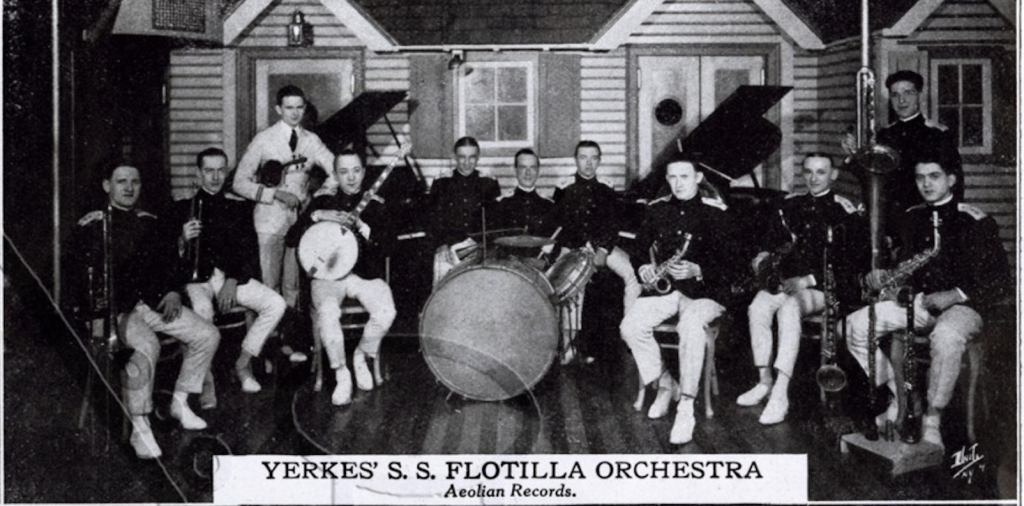 A gig with Yerkes would have been a musical and professional win for Argueso. Percussionist Harry Yerkes enjoyed a multifaceted career directing and managing several different varieties of popular bands. Argueso’s name often appears with Yerkes S.S. Flotilla Orchestra, the house band at the popular Manhattan restaurant led by violinist Richard Barton. Opening in April 1921, on 55th Street off Sixth Avenue, it was by all accounts a unique spot for dinner and dancing:
A gig with Yerkes would have been a musical and professional win for Argueso. Percussionist Harry Yerkes enjoyed a multifaceted career directing and managing several different varieties of popular bands. Argueso’s name often appears with Yerkes S.S. Flotilla Orchestra, the house band at the popular Manhattan restaurant led by violinist Richard Barton. Opening in April 1921, on 55th Street off Sixth Avenue, it was by all accounts a unique spot for dinner and dancing:
The interior represents three yachts tied at a dock. The dock itself is the dancing pavilion and is slightly elevated over the decks of the dining space and reached by gangways. The atmosphere is strictly maritime.
The nautical atmosphere begins at the very entrance of the S.S. Flotilla where lanterns are hung on either side of the doorway. A blue-bloused attendant adds his share of local color to the naval appearance of the restaurant…Between the pier and the side of the boat, the water of the dock laps and splashes. One might pause here for a moment in wonderment at the stout hawsers encircling the mooring posts. It would seem as though the boat were straining at them, anxious to be loosened and glide away…A curtain of green silk is swayed gently by the breezes from concealed electric fans and lighted by hidden lamps, thus producing the effects of a moving sea.
Both the venue and its band were a success. Visitors to the Flotilla praised the band, which would eventually tour as far as Australia. One commentator cited the band as a model for ensemble rhythm:
“You simply cannot listen to the music of an orchestra such as [Clyde Doerr, Paul Whiteman, St. Louis bandleader Benjamin Rader], or Yerkes’ S.S. Flotilla Orchestra without being impressed forcibly with the fact that what they are dispensing is rhythm—perfect, balanced, dependable—which carries your nerves along upon its pulsations irresistibly.”
Records back up this description. With Dominic Ciffarelli’s bass sax jamming on the one underneath, the band kept the tune clear but rhythmic—a song promoter and dancer’s dream. Instead of interlocking sections, the Flotilla band more often relied on a ringing unified ensemble sound topped by a golden lead trumpet. Most dance bands of the twenties used an alto sax lead for their sections. Soprano sax lead and trios were usually for specialty choruses. Yerkes treated the soprano as a standard lead on many records. “Blue” is an excellent example of an uncluttered, propulsive Flotilla record. Their reading of Zez Confrey’s piano novelty “Stumbling” shows off precise syncopation and pyramid effects.
Argueso’s business trip lines up with his second record date: a May 1921 session by Yerkes’ S.S. Flotilla Band for Vocalion. “Where The Lazy Mississippi Flows” is the only side from the May 1921 session that this writer is able to hear. It’s a sedate waltz that leaves little room to identify any player. Argueso, if he’s there, is hard to pick out.
Musician/historian Colin Hancock has extensively studied Batty DeMarcus’s life and sound. He hears DeMarcus’s alto on several Yerkes sides. With Gene Fosdick’s soprano and Dudley Fosdick’s mellophone, the three Indiana-born musicians created many hot trios on Yerkes record. Hancock explains that by the spring of 1922, DeMarcus began working more with Paul Whiteman’s Sax Sextette and Emil Coleman. Argueso might have taken over on alto or tenor. The broad-toned tenor on “Blue” from a June 1922 session doesn’t have the slight purr of Fosdick’s tenor. Neither does the tenor on “If I Had My Way, Pretty Baby” by Yerkes Happy Six from around the time.
Argueso is visible in a photograph of the Flotilla band from the Buescher instrument company’s first quarterly edition of its 1922 True Tone Journal. He holds an alto saxophone while a flute and clarinet rest on stands in front of him. Judging by the photo, Argueso and a tenor sax player with a nearby bass clarinet are the only reed doublers in the ensemble.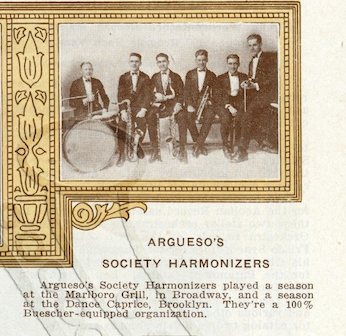
He also appears in the same publication leading Argueso’s Society Harmonizers, holding a tenor sax with an alto sax and a clarinet in front of him. Yerkes might have deputized Argueso as the leader of yet another one of his bands. Or it may have been just a publicity title; the violinist in the group could be Barton. It’s also unclear if the Harmonizers played concurrently with the Flotilla band. The caption only notes that the group “played a season at the Marlboro Grill on Broadway and a season at the Dance Caprice in Brooklyn.”
Alongside playing saxophone and bandleading, songwriting rounded out Argueso’s musical talents. He copyrighted several works as a composer and arranger in 1921. “Avon Blues,” “Gas Hound Blues,” “Friends Above All,” “I Hate the Thought of Ever Losing You,” “Just Dreaming Along,” and “Just for Spite” were presumably songs for voice and piano. “Hot Dog” was categorized as a one-step for saxophone. “Honey” is listed as a fox trot song published by Reca Music with lyrics by Lester Reis and music by Robert H. Casner arranged by Argueso.
Working With Dance Bands
A photograph of the Flotilla band taken on September 30, 1922, at St. Louis’s Missouri Theater does not include Argueso. Nor do any photos of the Yerkes band after that. Argueso might have wanted a different musical experience or a change of scenery. Younger bandleaders like Vincent Lopez and Paul Whiteman and newer styles may have started outpacing Yerkes. Radio broadcasts and recordings were making these groups widely known. Argueso might have seen the writing on the wall.
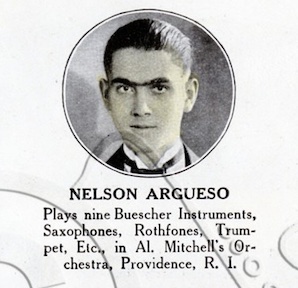
A 1923 Buescher catalog lists him playing saxes, Rothphones, and trumpet in Al Mitchell’s Providence, Rhode Island orchestra. This was a Whiteman-affiliated band whose leader played baritone sax in Whiteman’s Saxophone Sextette. Mitchell’s band didn’t record until 1934, after Argueso said he quit music.
Argueso had already earned a solid reputation. Variety reported that “this young Spanish [sic] reed expert is considered a ’find’ in his field” when he took the lead sax chair for Vincent Lopez. This mid-1924 announcement only mentions Lopez’s “club” orchestra.” By October 1924, Argueso was “in charge of the Vincent Lopez orchestra that opened Saturday at the Arcadia ballroom [in Providence], succeeding the Al Mitchell combination.”
He had moved from sideman to bandleader under contract with one of the country’s most thriving musical brands at the same venue. It may not have been the famous Lopez band from radio and records, but fronting one of Lopez’s satellite groups must have provided some professional cachet. It’s safe to say Argueso had talent and hustle.
Unfortunately, life in Rhode Island’s capital outweighed the benefits of playing with Lopez. The January 1925 issue of Variety reported Argueso had quit the Arcadia gig “because he was ‘dissatisfied’ with the city and is still with Lopez in a New York unit.” Though the circumstances are unknown, he appears to have been suspended from the Providence union in June 1926.
Still looking for a better opportunity, by April 1925, Argueso was playing with Mal Hallett’s New England-based band. Though this band never achieved the enormous popular success of Lopez, American Studies professor Roger House said that “by 1922, [Mal Hallett] was known as a top bandleader and showman…His orchestra provided a stable stream of one-night acts for Boston revelers.” Big band chronicler George T. Simon wrote, “Many musicians remember [Mallett] well and remain grateful to him for pioneering a swing band long before it was fashionable to do so and for always treating them and their music with the respect both he and they felt they deserved.”
No less than Duke Ellington praised the Hallett band on musical grounds. He told Downbeat that “[bands] had to be terrific in those days because that was when Mal Hallett had a band up in New England, and you had to play alongside him…they’d have battles of music. All these big bands used to come up from New York, and Mal Hallett would blow them right out over the Charles River. He just played big, fat arrangements of dance music, and most of his guys were legit, but they’d open up with a flag-waver, and that was it!”
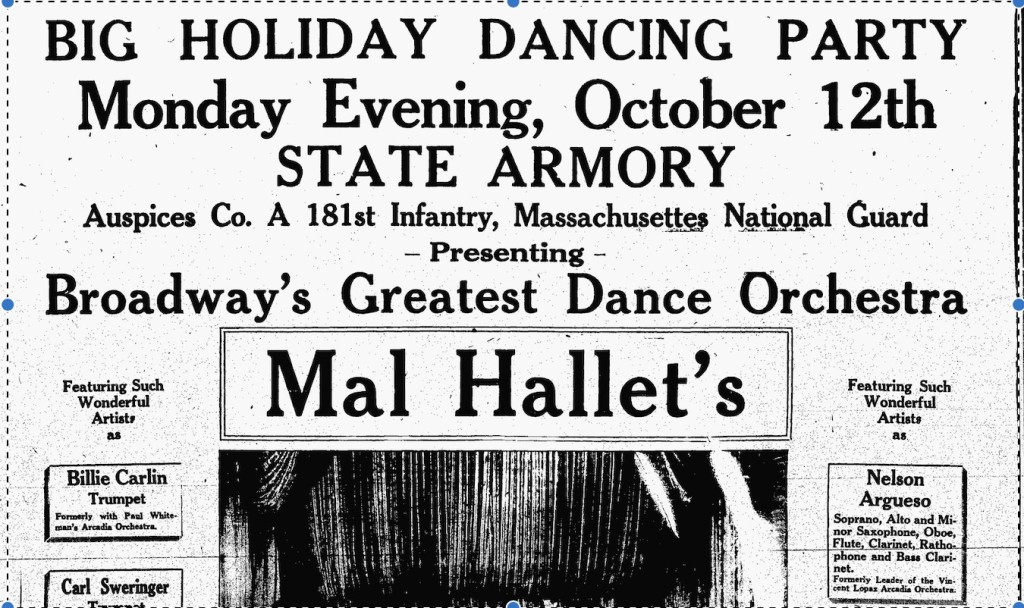
In addition to a nice boss, a good band, and steady work, Argueso now had star billing and a salary to match. New Hampshire’s Portsmouth Herald, covering a one-nighter by Hallett, singled out Argueso as “command[ing] one of the highest salaries paid any musician in America, and he is the outstanding feature of Hallett’s orchestra today.” Unusually for the time, a full-page ad for Hallett in the Fitchburg Sentinel months later spotlights each band member. Argueso’s billing is packed with instruments, including something called a “minor saxophone” and “Rathophone.”
That was likely the Rothphone, an instrument one musicologist described as “nothing but a sarrusophone built in saxophone form.” Argueso must have used the instrument for novelty effects. The instrument had a brief vogue in Italian military bands during the teens but was rarely heard on record. The Russo and Fiorito Oriole Orchestra’s 1922 recording of “Rose of the Rio Grande” features it in a humorous role. Maybe the Rothphone wowed wide-eared New Englanders on live dates.
On records from 1926 and 1927, Hallett’s “big, fat arrangements” emphasize his slick, punchy, thoroughly danceable ensemble. Soloists get their due, including a bright-toned alto inserting chromatic licks, a tenor player(s) alternating between a big, warm hotel band sound and a lighter “Northeastern tenor” style, and a clarinet squealing and slurring above the brass. “Whose Who Are You?” on Harmony features a hot bass clarinet. “My Idea of Heaven” for Columbia has a soprano soloist speaking in bunched-up phrases. Any of these players could be Argueso, but by 1929, Toots Mondello’s confident, swinging alto was in the spotlight.
Argueso’s time with Hallett looks like his longest continuous stint with a band. While ABDRF states that Mondello replaced Argueso in April 1927, Orchestra World shows both Argueso and Mondello in the band as of January 1929. At that time, the Hallett band signed with Vitaphone to appear in musical shorts (but the writer hasn’t been able to find these films to verify Argueso’s presence).
Film work must not have interested Argueso. And he might have had enough of New England. He had returned to New York at some point in 1929. By the time the New York City branch of the American Federation of Musicians (local 802) published that year’s directory, Argueso was living on West 137th Street in Harlem. A ship’s manifest dated September 11, 1929, shows him living in the Jackson Heights section of Queens. No spouse is listed on that trip from Buenos Aires, but Nelson and Marion are listed as returning from Bermuda in July 1932. This might have been a honeymoon, but it’s unclear when they married.
Leaving Music (Gradually)
Argueso told a Storyville correspondent that he completely quit the music business in 1932. He implied that Marion told him he had to “choose between music and her” as early as 1929. But Argueso’s Arcadian Orchestra provided dance music at a New Rochelle country club in February 1933. Union records show him transferring his membership to Mount Vernon, New York, in April 1933. He resigned from the Mount Vernon chapter in 1935 but remained a “traveling member” in White Plains through at least 1938.
Even more confusing, decades after the twenties stopped roaring, newspapers hint at Argueso recently working with Paul Whiteman. Reporting on Mr. and Mrs. Argueso visiting friends in July 1949, Vermont’s Burlington Free Press described Nelson as “formerly with the Paul Whiteman orchestra.” Three years later, when Marian was visiting another Vermont couple, the St. Albans Daily Messenger reported her husband as “the well-known trombonist with Paul Whiteman’s orchestra who recently [emphasis mine] left the Whiteman band to become a vice president of an advertising agency in New York.” Either these reporters used “formerly” and “recently” in the broadest chronological sense, or Argueso was moonlighting in lower brass.
If Argueso was still performing, he seems to have kept it close to the chest. A draft card dated 1942 shows he was already working for the Manhattan advertising agency Pedlar & Ryan. The same year, he graduated with honors from a program at the Advertising Club of New York. During the next few decades, various trade magazines announced Argueso’s professional comings and goings as comptroller, treasurer, and vice president at agencies like Doherty, Clifford, Steers & Shenfield and Sullivan, Stauffer, Colwell & Bayles.
Clocks and cars are the most well-documented aspects of his later life. The Reporter Dispatch details quite a clock collection. Argueso wrote several journal articles for the National Association of Watch and Clock Collectors. His classic car collection included three Packard models and a Daytona speedster he restored himself. He participated in car shows and served as treasurer for the Classic Car Club of America. He presumably retired in 1971 before moving to Pomona, Florida, and then North Carolina, where he spent his final days.
Possibilities
Nelson Argueso died on April 5, 1988, at 89. Long before that—supposedly—he had left music far behind him. Fans may find that strange. Unlike accounting, a musical career often gets romanticized. People who turn pitches and rhythm into art that moves and intrigues us seem to be doing more than a mere job.
To other observers, that line of work may seem strange or even less than respectable. Musicians keep non-traditional hours, scrape for work, and endure one-nighters without insurance and other perks. That’s without the wild stories involving substances and pre- or extra-marital sex. The tuxedoed neighbor pulling into the driveway at 3 am might have people on the block in White Plains talking. Writer and historian Mark Berresford has interviewed and corresponded with many musicians from this era. He points out that it was common for them to quit music when they married or had children.
Musicians, like anyone else, change careers for several reasons. Argueso’s precise reasons remain unknown. It may sound like his spouse gave him an ultimatum. But that’s one side of a conversation from decades earlier related secondhand. Reading it another way, it’s hard to criticize someone who wanted their spouse home. Ditto for a spouse who tried to make his better half happy. It’s also hard to fault a young couple who wanted more stability during the Great Depression. Plus, not every musician gets to collect expensive cars.
Yet there are still all those musical events after Argueso claimed to have left music. It’s possible that he misremembered when he quit. He might have worked occasional gigs that didn’t interfere with his professional or familial responsibilities. Maybe an active union membership had advantages, or maintaining it just made him feel comfortable. He could have done pickup jobs with Whiteman on the bandleader’s post-war radio shows and guest conductor spots. Perhaps Argueso meant “quit music” in a really liberal way.
That’s a lot of possibilities. They point to someone who either needed a lot of time to divest himself of music or someone who took their time closing an important chapter of their life. When a reporter came to discuss clocks decades later, it’s possible that he simply didn’t see his musical experience as noteworthy. But Argueso worked with some of the most famous and competitive bands. He earned accolades and a high salary for his talent. Maybe revisiting that part of his life was too difficult. It’s hard to know at this distance. Toward the end, he might have been ready to discuss what music meant to him before it was too late.
Anything is possible. Maybe he even took a solo.
Sources
To save space, reference materials are condensed to source names only. Readers can request a complete list (including dates, authors, and archival sources) from the writer.
The Story of the Buescher Saxophone; American Dance Bands on Record and Film by Richard J. Johnson and Bernard H. Shirley; American Federation of Musicians Local 802 records; American Society for Testing and Materials bulletin; Ben Rader-Russ David Music Collection at Southern Illinois University Edwardsville; email conversation, historical data, and images shared by Mark Berresford; Mark Berresford’s liner notes to Dance-O-Mania: Harry Yerkes and the Dawn of the Jazz Age, Rivermont CD BSW-1150; Billboard; Bridgeport Sunday Post [CT]; Broadcasting Telecasting [magazine]; Buescher True Tone Musical Journal; The Bulb Horn [Veteran Car Club of America]; Bulletin of the National Association of Watch and Clock Collectors; Burlington Free Press [VT]; The Chat [Brooklyn, NY]; Classic Car [magazine]; email conversation with staff from the Classic Car Club of America; Daily Argus [Mount Vernon, NY]; Detroit: Ragtime and the Jazz Age by Jon Milan cited on Bixography forum by Albert Haim; Downbeat as cited by Richard Vacca at richardvacca.com; Edison Monthly; Fitchburg Sentinel [MA]; email conversations with Colin Hancock; International Musician; South End Shout: Boston’s Forgotten Music Scene in the Jazz Age by Roger House; Jacobs’ Orchestra Monthly; audio of Sid Peltyn Orchestra shared by kspm0220s via dailymotion.com; Library of Congress Catalog of Copyright Entries; The Log [of the Circumnavigators Club]; The Music Trades; Orchestra World; Portsmouth Herald [NH]; Precision Metal Molding [journal]; Radio Annual; Reporter Dispatch [White Plains, NY]; “Sarrusophone, Rothphone and Reed Contrabass” by Gunther Joppig in Journal of the American Musical Instrument Society; The Big Bands by George T. Simon; Simeone Foundation Automotive Museum; Sponsor [magazine]; The Spur; St. Albans Daily Messenger; St. Louis Globe Democrat; St. Louis Post Dispatch; Standard Star [New Rochelle, NY]; Storyville; Television Digest; “The Changing Role of the Bass Saxophone” by David Robinson Jr. in Saxophone Journal; US Birth Records; US Census Records; US Draft Cards; US Passenger Manifests; US Passport Applications; US Social Security Death Index; Variety.
Gratitude
Thank you to Mark Berresford, Vince Giordano, Colin Hancock, Aaron Keebaugh, and Michael Steinman for generously sharing their musical insights, historical knowledge, editorial expertise, and especially their time! This writer always appreciates readers’ information and corrections.
Andrew J. Sammut has covered music for All About Jazz, The Boston Classical Review, The Boston Musical Intelligencer, Early Music America, The IAJRC Journal, and his blog The Pop of Yestercentury. Andrew also works as a freelance copyeditor and writer. He lives in Cambridge, Massachusetts, with his wife and his dog.






















